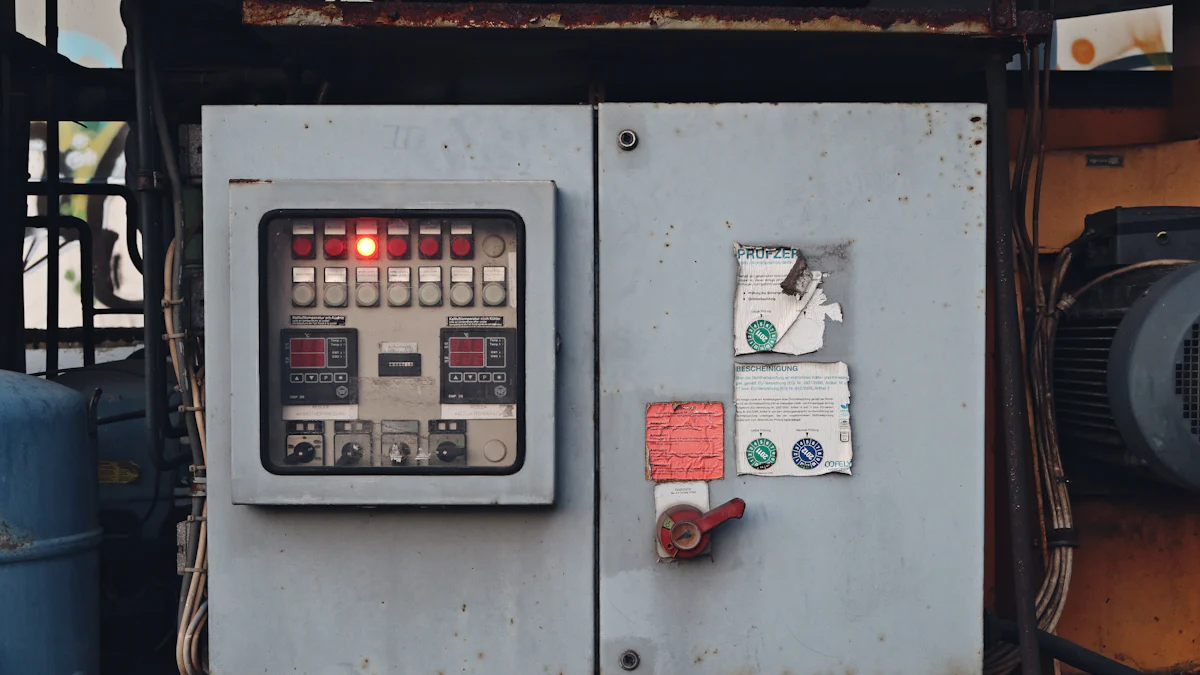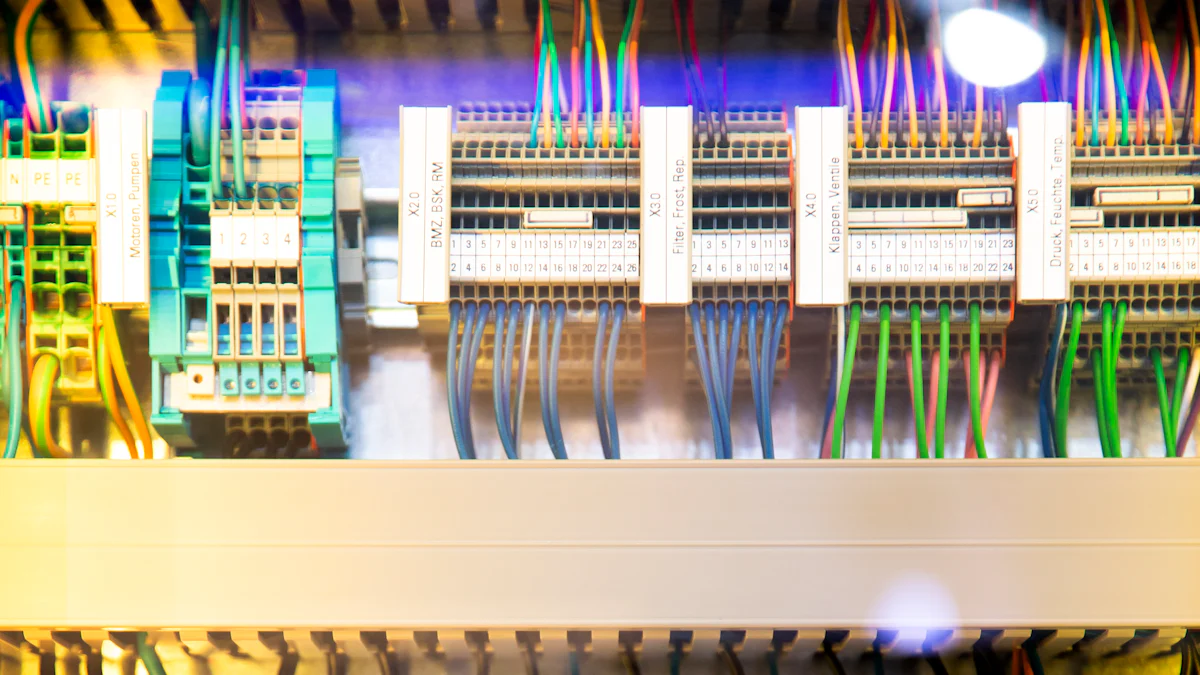
News

Efficient motor operation is crucial for reducing energy consumption in industrial and commercial settings. The AC Frequency Drive utilizes vector control in frequency inverters to optimize motor performance by precisely managing current and torque. This advanced control method ensures motors operate at the required speed and power, minimizing waste. By adjusting motor speed based on demand, frequency inverter vector drives improve energy efficiency and prevent unnecessary consumption.
Vector controls can achieve pump sleep and external wake-up functions to avoid excessive operation.With these capabilities, the AC Frequency Drive with frequency inverter vector control reduces operational costs and enhances system performance. It also ensures consistent feedback for better automation and stability, making it a cornerstone of modern electric drives.
Key Takeaways
Vector control in inverters helps motors work better and saves energy.
These drives let motors change speed and power as needed, saving energy and working more efficiently.
Using vector control makes motors last longer by reducing wear and heat, so they need fewer fixes and replacements.
Understanding frequency inverter vector control
What is vector control?
Vector control, also known as field-oriented control, is an advanced motor control technique used in frequency inverters. It allows you to manage the speed and torque of AC motors with precision. This technology works by breaking down the motor's stator current into two components: one for generating torque and the other for maintaining the magnetic field. By controlling these components independently, vector control ensures high efficiency and smooth operation. Unlike traditional methods, it makes an AC motor behave like a DC motor, offering superior performance and adaptability across various applications.
Role of frequency inverters in motor efficiency
Frequency inverters play a critical role in improving motor efficiency. They allow motors to operate at variable speeds, matching the motor's output to the specific demands of your application. This reduces unnecessary energy consumption and lowers operational costs. Features like soft start and stop minimize mechanical stress, extending the lifespan of your equipment. Additionally, frequency inverters enhance process control by delivering precise speed and torque adjustments. This results in smoother operation, reduced wear, and improved productivity. Their ability to adapt to load changes makes them indispensable in industrial settings.
Key differences between vector control and traditional methods
Vector control stands out from traditional motor control methods due to its superior efficiency and performance. Here are some key differences:
Vector control dynamically adjusts motor current for optimized torque and efficiency, while traditional methods maintain a fixed voltage-to-frequency ratio.
It provides high accuracy in speed control and smooth motor rotation across the full speed range.
Open-loop vector control delivers high torque at low speeds, while closed-loop systems can achieve up to 200% of rated torque at zero speed, ideal for demanding applications.
Traditional methods struggle with load fluctuations, but vector control handles them seamlessly without speed variation.
By adopting vector control through variable frequency drives, you can achieve significant energy savings, better motor stability, and enhanced system reliability.
Mechanisms of vector control for energy efficiency

Precise motor current allocation
Vector control ensures optimal current distribution in motors by separating the d-axis and q-axis current components. The d-axis current maintains the magnetic field, while the q-axis current generates torque. This separation allows you to maximize torque production and improve motor performance across various speeds.
Vector control dynamically adjusts motor current, ensuring the torque-producing component remains orthogonal to rotor flux.
This adjustment enhances efficiency, especially at low speeds or under high torque conditions.
Unlike scalar control, which relies on a fixed voltage-to-frequency ratio, vector drives achieve superior energy efficiency by tailoring current allocation to the motor's needs.
By optimizing current allocation, vector drives reduce energy consumption and improve the overall performance of high-efficiency motors.
Enhanced motor output torque and stability
Vector control enhances motor output torque by independently managing the d-axis and q-axis currents. This independent control ensures maximum torque production, even at low speeds. Sensorless vector drives use mathematical models instead of physical sensors, enabling high torque production while reducing costs. Closed-loop vector drives provide real-time feedback, delivering precise torque control and enabling up to 200% of the motor's rated torque at zero speed. This capability is essential for applications requiring high stability, such as elevators and hoists.
With these mechanisms, vector drives ensure consistent motor speed and torque boost, enhancing system reliability and efficiency.
Reduction of energy losses in motor operation
Vector control minimizes energy losses by reducing heat generation and optimizing magnetization. It adjusts output current based on load requirements, preventing unnecessary energy consumption when the load is lighter. By independently managing the magnetizing and torque-producing components, vector drives improve motor efficiency and reduce energy waste. This precise control not only lowers energy consumption but also extends the lifespan of your motors by reducing wear and tear.
By adopting this technology, you can achieve significant energy savings and enhance the performance of your electric drives.
Practical benefits of frequency inverter vector control
Cost Reduction Strategies
Lower Utility Bills
Using frequency inverter vector technology significantly reduces energy consumption. By dynamically adjusting motor speed and torque to match load requirements, vector drives optimize energy use. This efficiency translates into lower utility bills, especially in applications with variable loads like HVAC systems or manufacturing equipment. The precise control of motor output torque minimizes waste, ensuring energy-efficient operation.
Decreased Maintenance Costs
Vector drives reduce mechanical stress on motors by enabling soft starts and smooth operation. This minimizes wear and tear, leading to fewer breakdowns and lower maintenance costs. Additionally, the enhanced efficiency of vector control reduces heat generation, which extends the lifespan of components and decreases the frequency of repairs.
Performance Enhancements
Improved Torque Delivery
Vector drives excel in delivering high torque at low speeds, making them ideal for applications requiring precise control, such as elevators or hoists. By independently managing magnetizing and torque-producing currents, these drives ensure consistent torque boost even under challenging conditions.
Consistent Speed Regulation
Vector control maintains stable motor speed across varying loads. Closed-loop systems provide real-time feedback, allowing the motor to adapt quickly to load changes without compromising performance. This ensures smooth operation and enhances automation in industrial processes.
Environmental Impact
Reduced Carbon Footprint
By lowering energy consumption, frequency inverter vector drives contribute to a reduced carbon footprint. This makes them an environmentally friendly choice for industries aiming to meet sustainability goals.
Sustainable Energy Use
The energy-efficient operation of vector drives supports sustainable energy use. By optimizing motor performance, these drives ensure minimal waste, aligning with global efforts to conserve resources.
Longevity of Equipment
Extended Motor Lifespan
Vector control minimizes mechanical stress and heat generation, extending the lifespan of motors. Soft starts and smooth operation reduce wear, ensuring your equipment remains reliable for longer periods.
Fewer Replacement Needs
The enhanced efficiency of vector drives reduces the frequency of motor replacements. By optimizing performance and minimizing stress, these drives ensure your equipment operates at peak efficiency for years.
Operational Flexibility
Adaptability to Load Changes
Vector drives respond quickly to load changes, maintaining consistent motor speed and torque. This adaptability ensures smooth operation in dynamic environments, such as manufacturing lines or HVAC systems.
Enhanced System Integration
The advanced control capabilities of vector drives make them easy to integrate into complex industrial setups. Their ability to optimize motor performance and provide precise feedback enhances overall system efficiency and reliability.
Real-world applications of vector control
Case study: Manufacturing energy savings
Vector control has revolutionized energy use in manufacturing by optimizing motor performance and reducing waste. For example, Siemens drives implemented in a snack food production line achieved remarkable results. The production process improved by over 10%, while energy savings reached approximately 20%. This was possible because the system powered down when pans were empty, unlike traditional controls that consumed energy continuously. By integrating frequency inverter vector technology, manufacturers can achieve similar efficiency gains, reducing operational costs and enhancing productivity.
Application in HVAC systems for efficiency
HVAC systems benefit significantly from vector drives, which improve energy efficiency by controlling motor speed and current. These drives prevent unnecessary energy consumption by adjusting output based on load requirements. For instance, fan control systems use vector drives to match fan speed with demand, avoiding excessive airflow and energy waste. Similarly, compressor systems leverage this technology to fine-tune motor speed according to air demand, ensuring precise control and minimal energy use. By adopting vector drives, you can create energy-efficient HVAC systems that lower utility bills and support sustainable operations.
Renewable energy sector success stories
The renewable energy sector relies on vector drives to maximize efficiency and reliability. Wind turbines, for instance, use vector control to regulate motor speed and torque, ensuring optimal power generation even under fluctuating wind conditions. Solar power systems also benefit from this technology, as it enhances motor performance in tracking systems that align solar panels with the sun. By integrating vector drives, renewable energy systems achieve higher efficiency, reduced energy losses, and improved sustainability, making them a cornerstone of modern green energy solutions.
Vector control in frequency inverters revolutionizes motor performance by enhancing efficiency and reducing energy consumption. By optimizing motor output and minimizing waste, you can achieve significant cost savings and operational improvements. For instance, vector drives adjust current based on load conditions, preventing unnecessary energy use. Additionally, energy feedback technology recovers energy during braking, further reducing consumption.
The long-term benefits of adopting vector control are substantial. Improved efficiency lowers operational costs, while better speed and torque control enhances system performance. High torque at low speeds ensures precision in demanding applications like robotics. Reduced mechanical stress extends motor lifespan, minimizing replacement needs.
By implementing vector drives, you not only reduce your carbon footprint but also align with global energy efficiency goals. This technology ensures sustainable energy use, making it an essential investment for industries aiming to enhance productivity and reduce costs.
FAQ
What makes vector control more energy-efficient than traditional methods?
Vector control optimizes motor performance by adjusting current and torque precisely. This reduces energy waste, improves efficiency, and ensures motors operate only as needed.
Can vector control extend the lifespan of my equipment?
Yes, vector control minimizes mechanical stress and heat generation. This reduces wear and tear, ensuring your equipment lasts longer and operates more reliably.
Is vector control suitable for renewable energy applications?
Absolutely. Vector control enhances motor performance in renewable energy systems like wind turbines and solar trackers. It ensures efficient energy use and maximizes power generation under varying conditions.
Please give us a message